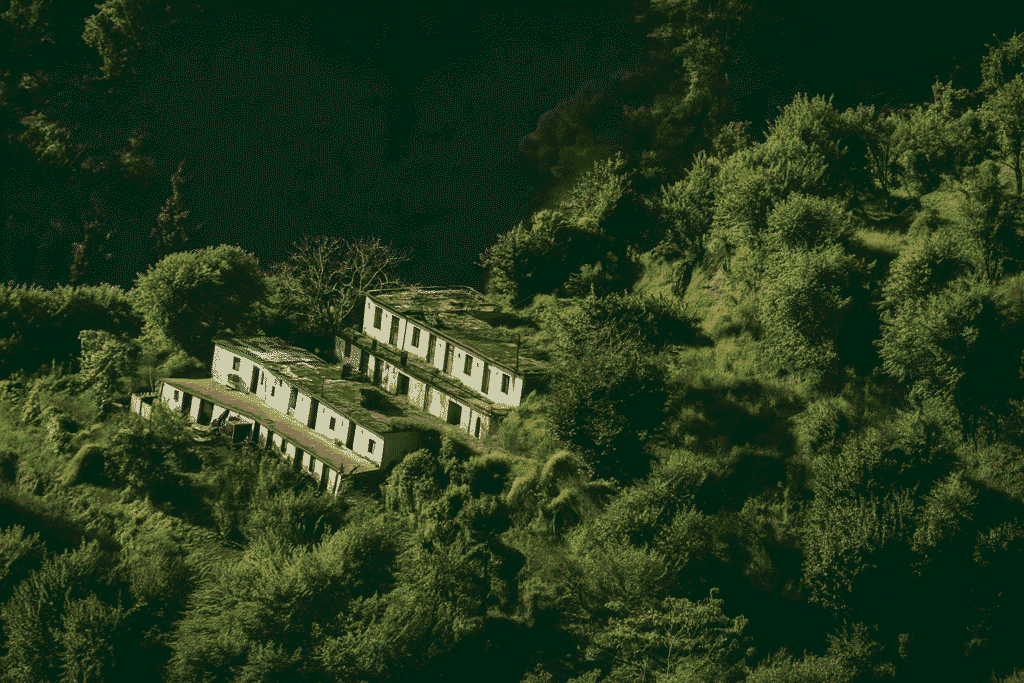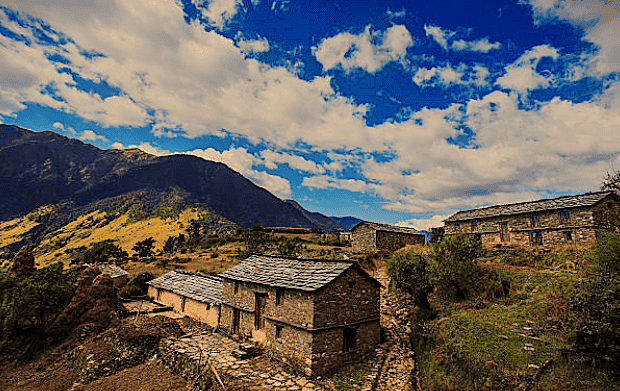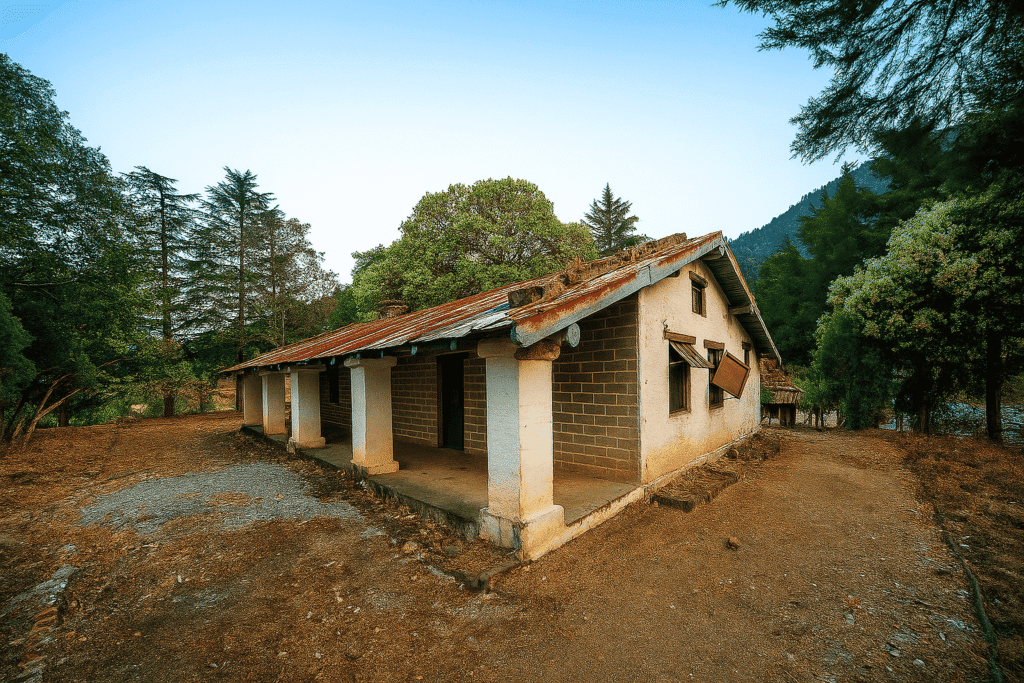
Introduction – Ghost Village in Uttarakhand
Picture this: a small Himalayan village, surrounded by pine forests and snow-capped peaks. The sun rises over terraced fields, women in colourful saris carry water from the spring, and children chase each other through dusty lanes. Now, fast-forward a few decades—those same lanes are empty, the houses are locked or broken, and the fields are wild with weeds. The only sound is the mountain wind whistling through abandoned doorways.
This isn’t a movie scene or a forgotten folktale—it’s happening in real life, in the ghost villages of Uttarakhand.
Uttarakhand, often referred to as “Devbhoomi” (Land of the Gods), is renowned for its temples, trekking trails, and spiritual ambience. Yet hidden within its valleys and ridges lies a quieter, more haunting reality: hundreds of villages abandoned and frozen in time.
What Exactly is a Ghost Village?
A ghost village is a settlement that once thrived but has now been abandoned, either entirely or almost entirely. The houses, temples, and schools remain, yet they stand in silence.
IIn Uttarakhand, these ghost villages were not deserted due to war or disease; instead, modern migration in search of a better life is the main reason.

The Story of Uttarakhand’s Empty Villages
According to official records, Uttarakhand has more than 1,700 ghost villages—and the number is growing. In many others, only one or two families remain.
Migration in these mountains began decades ago, but it accelerated in recent years. Younger people left to find jobs in cities, better schools for their children, and hospitals that could save lives in an emergency.
What’s left behind is more than just empty buildings—it’s a fading culture, forgotten traditions, and a way of life that existed for centuries.
Why Did People Leave? – The Main Reasons
1. Lack of Employment
Agriculture has always been the backbone of these villages; however, farming in the mountains is a risky endeavour. A sudden hailstorm can destroy crops. Monkeys, wild boars, and other animals often raid fields. Without factories or businesses nearby, there are no alternative jobs.
2. Education and Healthcare Gaps
In some villages, the nearest school is 5–10 km away, and higher education is almost impossible without moving. The same goes for healthcare—many villages have no clinics, and reaching a hospital can take hours of walking.
3. Natural Disasters
The Himalayan region is prone to landslides, earthquakes, and floods. Disasters like the 2013 Kedarnath floods made many families decide they could not risk staying in such vulnerable locations.
4. The Pull of Modern Life
Cities offer electricity 24/7, high-speed internet, shopping malls, and entertainment—luxuries that can be hard to resist, especially for younger generations.
The Emotional Side – Empty Homes, Empty Hearts
Leaving a village is not just about geography—it’s about leaving behind memories, roots, and identity.
Elderly residents often speak with tears in their eyes about the festivals when every house would light up, the collective farming days when neighbours helped each other, and the evenings when people gathered to sing folk songs.
Now, they sit alone on porches, watching the sunset over silent lanes, wondering if their grandchildren will ever know the meaning of “home” in the same way.
Nature’s Comeback – When the Forest Takes Over
One fascinating thing about ghost villages is watching how nature reclaims the land.
Houses are covered in moss. Vines creep up the walls and into windows. Roofs collapse under the weight of weeds. Wild animals roam freely through what used to be kitchens and bedrooms.
It’s beautiful in a bittersweet way—proof that nature never really leaves; it just waits for its chance to return.

Real-Life Ghost Villages in Uttarakhand
Kwasaur Village (Chamoli District)
Once a bustling farming community, Kwasaur is now almost empty. The few remaining families live in stone houses surrounded by abandoned fields. In spring, wildflowers cover the paths where children once played.
Chowki Village (Pauri Garhwal)
Known for its breathtaking view of the Himalayas, Chowki had more than 300 residents a few decades ago. Today, there are fewer than 20. Tourists come here for trekking, but the silence feels almost sacred.
Liti Village (Bageshwar)
Liti is often called “the village where time stands still.” Walking through it is like stepping into the past—mud houses with wooden carvings, an old temple bell still hanging, but no one to ring it.
Local Voices – Stories from Those Who Stayed
I met an elderly man in a near-empty village in Pauri Garhwal. His children live in Dehradun, and his wife passed away years ago. He said, “I will not leave. This is my home. I want to breathe my last here, even if I am the only one left.”
Another woman in Chamoli told me that during Diwali, she lights diyas in the homes of neighbours who have moved away, so the village still “looks alive” for the gods.
These stories show that ghost villages are not just about economics—they’re about love, loyalty, and loss.
Ghost Villages and Tourism – A New Hope
Some ghost villages are slowly finding a new life through tourism. Photographers, trekkers, and history lovers come to see the ruins, hear the stories, and experience the untouched beauty of these places.
If developed carefully, rural tourism could:
- Provide income for locals
- Preserve cultural heritage
- Reduce migration
Home-stays, trekking tours, and craft workshops could help villages survive—without losing their soul.
Legends and Myths – Mystery in the Mountains
Empty places invite stories, and ghost villages are no exception.
Some locals whisper about strange lights in the fields at night, footsteps on empty paths, or the sound of temple bells ringing when no one is there.
Whether these are real, imagined, or just the wind playing tricks, they add to the intrigue. For adventurous travellers, the idea of exploring a “haunted” Himalayan village is irresistible.

Government Efforts – Can These Villages Be Saved?
The Uttarakhand government has been trying to address migration with initiatives such as:
- Rural Tourism Promotion – Encouraging visitors to stay in villages and experience local life.
- Infrastructure Projects – Better roads, electricity, and mobile networks.
- Skill Development – Training villagers in tourism, handicrafts, and farming techniques.
Progress is slow, but there is hope that with the right balance of development and preservation, some villages might come back to life.
Travel Guide – Visiting a Ghost Village in Uttarakhand
Best Time to Visit: March–June (spring/summer) or September–November (autumn) for pleasant weather.
How to Reach: Most ghost villages require trekking from the nearest road head. This could mean anything from a 1-hour walk to a full-day hike.
What to Bring:
- Comfortable walking shoes
- Water and snacks
- Camera for photography
- Respect for local traditions and property
Travel Tips:
- Hire a local guide—they know the safest paths and can share stories you won’t find online.
- Avoid visiting at night unless you’re with an experienced group.
- Support the local economy—buy handmade goods or stay in village homestays if available.
The Future – Will They Come Back to Life?
There’s no easy answer. Migration is a global phenomenon, and once a village is abandoned, it’s hard to bring it back. But with remote work becoming more popular and tourism growing, there’s a chance that some ghost villages could be revived.
Perhaps in the future, children will once again run through these lanes, temple bells will ring in the morning, and fields will be green with crops.
Until then, these villages stand as silent witnesses to change—beautiful, mysterious, and timeless.
Conclusion – Silent Stories in the Himalayas
Uttarakhand’s ghost villages are not just abandoned places—they are living history. They remind us of the balance we must strike between progress and tradition.
When you walk through one of these villages, you don’t just see ruins—you feel the presence of all the lives that once filled the space. You hear echoes of laughter, festival drums, and the hum of a community that believed in togetherness.
In their silence, they speak louder than any bustling city street: Don’t forget where you came from.
FAQs
Ans. A Ghost Village in Uttarakhand is a settlement that was once populated but has been abandoned over time. Houses, temples, and schools remain, giving a haunting glimpse of the past.
Ans. Most villages in Uttarakhand were abandoned due to migration. People moved to cities seeking better jobs, education, and living conditions.
Ans. Yes, most ghost villages are safe to explore during the day. However, it’s recommended to hire a local guide and avoid visiting alone at night.
Ans. Many ghost villages are located in remote valleys. You can reach them by road or on foot. Popular entry points are nearby towns like Dehradun, Uttarkashi, or Chamoli.
Ans. The best time to visit is between March and October, when the weather is pleasant and roads are accessible. Avoid the monsoon season due to landslides.